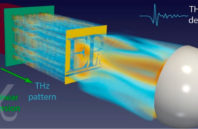Using a single-pixel camera operating at THz frequencies, researchers at the University of Sussex have discovered a way to capture with a high degree of accuracy not just the shape of an object, but also its chemical composition. The technique uses time-resolved measurement to reconstruct the complexity of an object.
The Sussex team’s approach was to illuminate an object with patterns of THz light containing a broad spectrum of colors. The team then used a single-pixel camera to capture the light that the object reflected for each pattern. The camera was able to detect how the pulse of light was altered in time by the object, even if the THz pulse was an extremely short event. Based on this information and what was known about the shape of the patterns, the researchers were able to derive the shape and composition of the object.
The novel methodology, which the researchers describe as nonlinear ghost imaging, theoretically demonstrates potential advantages over state-of-the-art imaging systems for the THz frequency range.

 (585) 768-2513
(585) 768-2513

